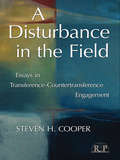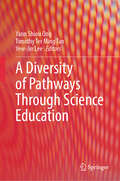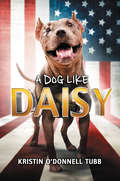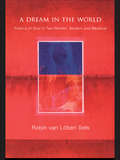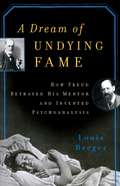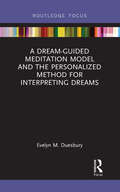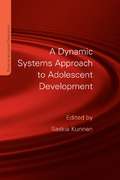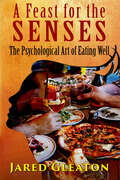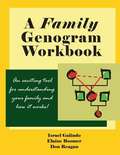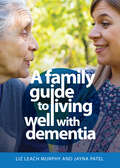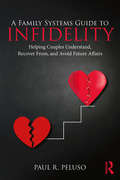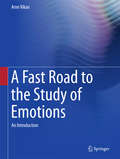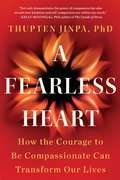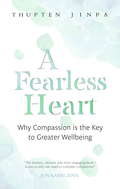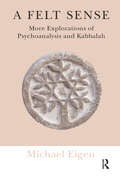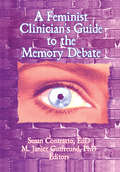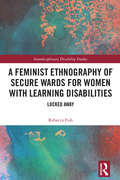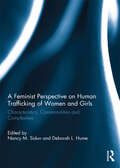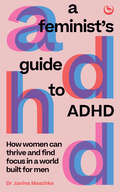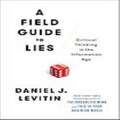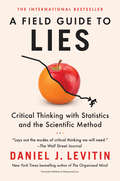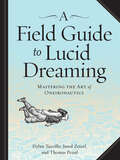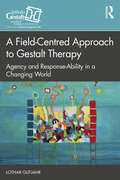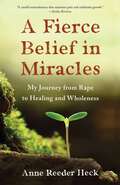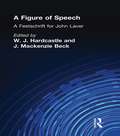- Table View
- List View
A Disturbance in the Field: Essays in Transference-Countertransference Engagement (Relational Perspectives Book Series)
by Steven H. CooperThe field, as Steven Cooper describes it, is comprised of the inextricably related worlds of internalized object relations and interpersonal interaction. Furthermore, the analytic dyad is neither static nor smooth sailing. Eventually, the rigorous work of psychoanalysis will offer a fraught opportunity to work through the most disturbing elements of a patient's inner life as expressed and experienced by the analyst - indeed, a disturbance in the field. How best to proceed when such tricky yet altogether common therapeutic situations arise, and what aspects of transference/countertransference should be explored in the service of continued, productive analysis? These are two of the questions that Steven Cooper explores in this far-ranging collection of essays on potentially thorny areas of the craft. His essays try to locate some of the most ineffable types of situations for the analyst to take up with patients, such as the underlying grandiosity of self-criticism; the problems of too much congruence between what patients fantasize about and analysts wish to provide; and the importance of analyzing hostile and aggressive aspects of erotic transference. He also tries to turn inside-out the complexity of hostile transference and countertransference phenomena to find out more about what our patients are looking for and repudiating. Finally, Cooper raises questions about some of our conventional definitions of what constitutes the psychoanalytic process. Provocatively, he takes up the analyst's countertransference to the psychoanalytic method itself, including his responsibility and sources of gratification in the work. It is at once a deeply clinical book and one that takes a post-tribal approach to psychoanalytic theory - relational, contemporary Kleinian, and contemporary Freudian analysts alike will find much to think about and debate here.
A Diversity of Pathways Through Science Education
by Yew-Jin Lee Yann Shiou Ong Timothy Ter Ming TanThis book presents the work of academics who contributed their work at the International Science Education Conference (ISEC) 2021, in alignment with the conference theme '20/20 Vision for Science Education Research.' Collectively, the chapters aim to evoke intellectual dialogues on current and future trends in science education. It features chapters that are grouped thematically into three sections: Questions and Questioning in Science/STEM education, Developing Science Teaching and Assessment, and History, Philosophy, and Sociology of Science/Engineering, and Informal Learning. Through the various sections, the book presents empirical studies in science and engineering classrooms or laboratories, puts forward a framework for problem-based learning, provides an account of a prominent scientist’s efforts in promoting practical science through analysis of historical documents, and uncovers trends in informal science learning space research through a review of literature. Each section is introduced by a commentary with further insights and thought-provoking questions on ideas raised in the chapters. The book also includes a 'Notes to Our Future Colleagues' section in each chapter, which presents readers with a collective vision for the state of science education research in the year 2050.
A Dog Like Daisy
by Kristin O'Donnell TubbMax meets A Dog Called Homeless in this sweet and poignant middle grade novel told from the humorous, thoughtful perspective of a rescued pit bull as she trains to be a service dog for an injured veteran and his family.Daisy has only ten weeks to prove her usefulness or else be sent back to the pound. Yet if she goes back, who will protect Colonel Victor from his PTSD attacks? Or save the littler human, Micah, from those infernal ear muzzles he calls earphones? What if no one ever adopts her again?Determined to become the elite protector the colonel needs, Daisy vows to ace the service dog test. She’ll accept the ridiculous leash and learn to sit, heel, shake, even do your business, Daisy when told to. But Daisy must first learn how to face her own fears from the past or risk losing the family she’s so desperate to guard—again.
A Dream in the World: Poetics of Soul in Two Women, Modern and Medieval
by Robin van Lõben SelsHow can science and religion co-exist in the modern discipline of psychotherapy? A Dream in the World explores the interfaces between religious experience and dream analysis. At the heart of this book is a selection of dreams presented by the author's patient during analysis, which are compared with the dreams of Hadewijch, a thirteenth century woman mystic. The patient's dreams led the modern woman to an unanticipated breakthrough encounter with the divine, her "experience of soul". The experience reoriented and energized her life, and became her "dream-in-the-world". Following Jung's idea that the psyche has a religious instinct, Robin van Loben Sels demonstrates that the healing process possible through psychotherapy can come from beyond the psyche and can not be explained by our usual theories of scientific psychology.Written in flowing, easily-read language A Dream in the World details a classical Jungian analysis of a woman's dreams, and searches the relationship between religious encounter, psyche and soul.
A Dream of Undying Fame: How Freud Betrayed His Mentor and Invented Psychoanalysis
by Louis BregerIn 1877, a young Freud met an established physician named Josef Breuer and they began a collaboration that would lead to the publication of the classic work, Studies on Hysteria. But by the time it released, Freud was moving to establish himself as a major figure in the treatment of mentally ill patients, and would let no one stand in his way. He consequently minimized Breuer’s contributions, betraying his former mentor and benefactor. In A Dream of Undying Fame, renowned psychologist Louis Breger narrates the story behind the creation of Studies as well as the case of Anna O. , which helped contribute to Freud’s definition of "neurosis. ” Breger reveals that Freud’s own self-mythologizing and history not only affected everything he did in life, but also helped shape his emerging beliefs about psychoanalysis. Illustrating the importance of personality and social context behind an intellectual breakthrough, Breger provides an in-depth look at a field that reshaped our understanding of what it means to be human.
A Dream-Guided Meditation Model and the Personalized Method for Interpreting Dreams (Routledge Focus on Mental Health)
by Evelyn M. DuesburyA Dream-Guided Meditation Model and the Personalized Method for Interpreting Dreams presents a model for meditation that counselors can use with clients regardless of gender, race, national origin, religion, age, or marital status. Using the model, readers can, if they wish, learn to interpret nighttime dreams. Even readers who choose not to learn to interpret their dreams may find that the meditation model assists with dream guidance.
A Dynamic Systems Approach to Adolescent Development (Studies in Adolescent Development)
by Saskia KunnenThe dynamic systems approach is a rapidly expanding advancement in the study of developmental research, particularly in the domain of adolescent development. It provides a unique way of examining the subject, and this innovative study of developmental processes helps social scientists to translate dynamic systems conceptualizations into clear empirical research that readers will be able to implement themselves. The first part of this edited book discusses techniques that describe and assess specific process characteristics such as variability, sudden jumps and attractor states. The second part explores the different techniques for building a dynamic systems model, which can simulate the behaviour of a system to investigate the mechanisms behind the processes. Each chapter describes one technique and is based on a specific practical example of its application in adolescent development. Step-by-step instructions for model-building and examples of ready-made models are provided on the website that belongs to the book: www.psypress.com/dynamic-systems-approach. This book provides a clear step-by-step description of theories and techniques that are designed for the study of developmental processes, and is therefore ideal for researchers of developmental psychology who do not specialise in statistics or research methods.
A FEAST FOR THE SENSES: THE PSYCHOLOGICAL ART OF EATING WELL
by Jared Scofield GleatonIndulge in a culinary odyssey where each dish tells a story, and every bite unlocks memories. In "A Feast for the Senses: The Psychological Art of Eating Well," author Jared Gleaton takes readers on a journey through the culinary experience. From cherished family recipes to Oklahoma's vibrant dining scene, Gleaton intertwines tradition, taste, and texture. As the son of a renowned "pie fiend," his exploration of food is both personal and profound, offering a rich feast for the senses. Through vivid storytelling, he unveils the art of "foodology" - where taste, smell, touch, vision, and sound converge to create unforgettable experiences. Whether reminiscing about family gatherings or embarking on new adventures, this book will nourish both body and soul. Join Gleaton at the table and feast on the rich tapestry of life, one bite at a time. Jared Gleaton is a nationally certified school psychologist and passionate food reviewer. With degrees in Psychology and Educational Leadership, Jared combines his academic expertise with his culinary enthusiasm to explore the intersection of psychology and food Residing in Bartlesville, Oklahoma, he brings regional pride and New England roots to his reviews, uncovering the stories and emotions behind each dish. Jared's work celebrates connection and understanding through food, inviting readers to join him on a sensory journey of gastronomic enlightenment.
A Family Genogram Workbook
by Israel Galindo Elaine Boomer Don ReaganA Family Genogram Workbook, by Israel Galindo, Elaine Boomer, and Don Reagan, is an easy to use, but powerful, guide to understanding your family and how it shaped you. This workbook will take you step-by-step to learn how to create your own family genogram. A genogram is an exciting tool for understanding and interpreting family history and relationships. By working through various exercises and activities in A Family Genogram Workbook you will gain insight into your family and your place in it. The workbook has four chapters. The first, a tutorial, shows readers, step-by-step, how to create their own family genogram so that they can quickly reap the benefits of this powerful tool for understanding family emotional process. The workbook format contains work pages so the reader can create a genogram right in the book. Subsequent chapters provide basic information on how to interpret and how to use the genogram. The chapter titled The 20 Questions to Ask About Your Family will help readers focus on key issues related to family emotional process. By working through various exercises and activities in A Family Genogram Workbook readers will gain insight into their families, how they work, and their place in it. Along the way, readers will also acquire an understanding of basic Family Systems Theory concepts and terminology. This resource is suitable for courses on family systems, social work practice, individual or group study, marriage and family retreats or workshops, for premarital counseling with couples or blended families, coaching relationships, or for personal use.
A Family Guide to Living Well with Dementia
by Liz Leach Murphy Jayna PatelGain the knowledge and insight you need to support your loved one with dementia to live life as they wish. When a family member is diagnosed with dementia it’s difficult to know what to do. Do you worry you don’t have the skills and knowledge to support them? And what about looking after your own mental health?A Family Guide to Living Well with Dementia is here to help. Written by someone with lots of experience in this field, it gives you the knowledge and insight to be able to support the person with dementia to live life as they wish. This easy-to-follow and accessible guide contains information that is intended to support people to plan for how they want to live their life, receive their care, and for end-of-life planning.In this book you will find: Details of the different types of dementia and the dementia journey Explanations of the various Person Centred approaches to dementia care Information about people's rights within the health and social care legislation Insights into behaviour and methods of communication Support options available to you and your loved one, paid and community-based. Often people who have been diagnosed with dementia and their families report feeling lost and not sure what to do apart from learning to adapt and find a way to do their best in what can often be difficult circumstances. This book provides easy, engaging, and practical content for things to consider and conversations to have so as to be able to provide the best care and support on a basis of sound understanding from everyone involved.
A Family Systems Guide to Infidelity: Helping Couples Understand, Recover From, and Avoid Future Affairs (Family Systems Counseling: Innovations Then and Now)
by Paul R. PelusoA Family Systems Guide to Infidelity offers an explanatory model and concrete techniques, enabling therapists and counselors to treat the core of a couple’s relationship problems instead of merely applying a therapeutic bandage. Chapters give therapists proven techniques to help couples redevelop trust, rebalance power, increase satisfaction, and recover from the wounds that infidelity causes. This text uses case studies from clinical practice, examples of public or historical figures, and scenarios from popular movies to illustrate concepts, and it provides a systemic explanatory model for understanding infidelity, one that focuses on marital dissatisfaction, power imbalances, unfulfilled dreams, and the discovery of infidelity.
A Fast Road to the Study of Emotions: An Introduction
by Arne VikanThis book is an ideal introduction to work in psychology and the neurosciences. Walking us through the key topics including historical, developmental and cultural perspectives, the book shows that the different types of emotions each is an evolved adaptive structure that serves a functional purpose. It is shown how these types are expressed differently on the human face, how they are developed in the child, and how they influence and are influenced by culture, health and the ways persons think and perceive. Knowledge of emotions is essential for anyone who plans to work, or whose work already involves, helping, instructing, negotiating, or controlling others. This introductory-level book teaches undergraduates as well as general readers the main components and methods, and helps readers to better understand how emotions operate both within the body and out in the world. It is a valuable resource for undergraduate students in psychology, nursing, social work, physiotherapy and occupational therapy find this book an important accompaniment.
A Fearless Heart
by Thupten JinpaThe Buddhist practice of mindfulness caught on in the west when we began to understand the everyday, personal benefits it brought us. Now, in this extraordinary book, the highly acclaimed thought leader and longtime English translator of His Holiness the Dalai Lama shows us that compassion can bring us even more. Based on the landmark course in compassion training Jinpa helped create at Stanford Medical School, A Fearless Heart shows us that we actually fear compassion. We worry that if we are too compassionate with others we will be taken advantage of, and if we are too compassionate with ourselves we will turn into slackers. Using science, insights from both classical Buddhist and western psychology, and stories both from others and from his own extraordinary life, Jinpa shows us how to train our compassion muscle to relieve stress, fight depression, improve our health, achieve our goals, and change our world. Practical, spiritual, and immediately relevant, A Fearless Heart will speak to readers of The Art of Happiness and Wherever You Go, There You Are.
A Fearless Heart: Why Compassion is the Key to Greater Wellbeing
by Thupten Jinpa'[A] timely book on compassion and its cultivation' The Dalai Lama'The bravest, cleverest and most engaging book I know on why we need to cultivate compassion' Jon Kabat-Zinn'A practical toolkit for becoming a better human being' Daniel Goleman Self-compassion is the overlooked key to achieving our goals. It can lead to increased happiness, stress reduction, a stronger sense of purpose, better health and a longer life. Yet many of us resist compassion, worrying that if we are too compassionate with others we will be taken advantage of and if we are too compassionate with ourselves we won't achieve our goals in life. Using the latest science, psychology (from contemporary Western and classical Buddhist sources) as well as stories from others and his own extraordinary life, Jinpa shows us how to train our compassion muscle. His powerful programme, derived from his remarkable course in Compassion Cultivation Training (CCT), is the perfect guide to achieving a greater sense of wellbeing.
A Felt Sense: More Explorations of Psychoanalysis and Kabbalah
by Michael EigenThis book explores the intertwining of myth, dream, and everyday reality, which mark the prose and poetry of both. It focuses on psychic reality, with psychoanalysis and Kabbalah tools in this great enterprise of learning to work with ourselves.
A Feminist Clinician's Guide to the Memory Debate (Women And Therapy Ser. #Vol. 19, No. 1)
by Susan Contratto M. Janice GutfreundFirst published in 1997. Routledge is an imprint of Taylor & Francis, an informa company.
A Feminist Ethnography of Secure Wards for Women with Learning Disabilities: Locked Away (Interdisciplinary Disability Studies)
by Rebecca FishWhat is life like for women with learning disabilities detained in a secure unit? This book presents a unique ethnographic study conducted in a contemporary institution in England. Rebecca Fish takes an interdisciplinary approach, drawing on both the social model of disability and intersectional feminist methodology, to explore the reasons why the women were placed in the unit, as well their experiences of day-to-day life as played out through relationships with staff and other residents. She raises important questions about the purpose of such units and the services they offer. Through making the women’s voices heard, this book presents their experiences and unique perspectives on topics such as seclusion, restraint, and resistance. Exploring how the ever present power disparity works to regulate women’s behaviour, the book shows how institutional responses replicate women’s bad experiences from the past, and how women’s responses are seen as pathological. It demonstrates that women are not passive recipients of care, but shape their own identity and futures, sometimes by resisting the norms expected of them (within allowed limits) and sometimes by transgressing the rules. These insights thus challenge traditional institutional accounts of gender, learning disability and deviance and highlight areas for reform in policy, practice, methodology, and social theory. This ground-breaking book will be of interest to scholars, students, policymakers and advocates working in the fields of learning disability and disability studies more widely, gender studies and sociology.
A Feminist Perspective on Human Trafficking of Women and Girls: Characteristics, Commonalities and Complexities
by Nancy M. Sidun and Deborah L. HumeFocusing on the trafficking of women and girls from a feminist perspective, this book examines how social structures and gender influence human trafficking. While women and girls are not the only victims of trafficking, they tend to be disproportionally represented. Structural inequities – including poverty, gender-based violence, racism, class and caste-based discrimination and other forms of oppression and marginalization – place some individuals at substantially greater risk to be trafficked. The contributors explore topics including trauma-informed assessment of, and therapy with, survivors of human trafficking; issues facing children of trafficked women when they are reintegrated into their communities post-trafficking; the intersection of trafficking with racial and cultural oppression; critical aspects of international sex trafficking; and commercial sexual exploitation of children. The book concludes with a discussion of how human trafficking intersects with both intracountry adoption and brokered marriages. This book was originally published as a special issue of Women & Therapy.
A Feminist's Guide to ADHD: How women can thrive and find focus in a world built for men
by Janina MaschkeAn empowering, feminist guide to understanding and managing ADHD for women, written by a popular millennial doctor with ADHD.ADHD affects women in unique ways. Discover how to deal with it – and how to thrive – in this empowering guide.Whether you have received a late diagnosis, a misdiagnosis – or even no diagnosis at all but think this might apply to you – experienced coach Dr Janina Maschke offers guidance and support to all women and girls impacted by ADHD. As well as featuring the latest research, personal case-studies and practical exercises, this book gives you tips on thriving with ADHD and embracing neurodiversity.You will learn:the role of gender in understanding ADHDthe challenges of diagnosing womenthe differences between the subtypesthe role of hormones in treating symptomscommon co-existing conditionstools for thriving with ADHD.Whether you&’re seeking information pre-diagnosis or looking to manage your symptoms, this is a must-read for all women impacted by ADHD.
A Field Guide to Lies: Critical Thinking in the Information Age
by Daniel J. LevitinFrom The New York Times bestselling author of THE ORGANIZED MIND and THIS IS YOUR BRAIN ON MUSIC, a primer to the critical thinking that is more necessary now than ever. We are bombarded with more information each day than our brains can process--especially in election season. It's raining bad data, half-truths, and even outright lies. New York Times bestselling author Daniel J. Levitin shows how to recognize misleading announcements, statistics, graphs, and written reports revealing the ways lying weasels can use them. It's becoming harder to separate the wheat from the digital chaff. How do we distinguish misinformation, pseudo-facts, distortions, and outright lies from reliable information? Levitin groups his field guide into two categories--statistical infomation and faulty arguments--ultimately showing how science is the bedrock of critical thinking. Infoliteracy means understanding that there are hierarchies of source quality and bias that variously distort our information feeds via every media channel, including social media. We may expect newspapers, bloggers, the government, and Wikipedia to be factually and logically correct, but they so often aren't. We need to think critically about the words and numbers we encounter if we want to be successful at work, at play, and in making the most of our lives. This means checking the plausibility and reasoning--not passively accepting information, repeating it, and making decisions based on it. Readers learn to avoid the extremes of passive gullibility and cynical rejection. Levitin's charming, entertaining, accessible guide can help anyone wake up to a whole lot of things that aren't so. And catch some lying weasels in their tracks!
A Field Guide to Lies: Critical Thinking with Statistics and the Scientific Method
by Daniel J. LevitinWinner of the National Business Book AwardFrom the New York Times bestselling author of The Organized Mind and This Is Your Brain on Music, a primer to the critical thinking that is more necessary now than ever We are bombarded with more information each day than our brains can process—especially in election season. It's raining bad data, half-truths, and even outright lies. New York Times bestselling author Daniel J. Levitin shows how to recognize misleading announcements, statistics, graphs, and written reports, revealing the ways lying weasels can use them. It's becoming harder to separate the wheat from the digital chaff. How do we distinguish misinformation, pseudo-facts, and distortions from reliable information? Levitin groups his field guide into two categories—statistical information and faulty arguments—ultimately showing how science is the bedrock of critical thinking. Infoliteracy means understanding that there are hierarchies of source quality and bias that variously distort our information feeds via every media channel, including social media. We may expect newspapers, bloggers, the government, and Wikipedia to be factually and logically correct, but they so often aren't. We need to think critically about the words and numbers we encounter if we want to be successful at work, at play, and in making the most of our lives. This means checking the plausibility and reasoning—not passively accepting information, repeating it, and making decisions based on it. Readers learn to avoid the extremes of passive gullibility and cynical rejection. Levitin's charming, entertaining, accessible guide can help anyone wake up to a whole lot of things that aren't so. And catch some weasels in their tracks!
A Field Guide to Lucid Dreaming: Mastering the Art of Oneironautics
by Dylan Tuccillo Jared Zeizel Thomas PeiselImagine being able to fly. Walk through walls. Shape-shift. Breathe underwater. Conjure loved ones—or total strangers—out of thin air. Imagine experiencing your nighttime dreams with the same awareness you possess right now—fully functioning memory, imagination, and self-awareness. Imagine being able to use this power to be more creative, solve problems, and discover a deep sense of well-being.This is lucid dreaming—the ability to know you are dreaming while you are in a dream, and then consciously explore and change the elements of the dream. A Field Guide to Lucid Dreaming, with its evocative retro illustrations, shows exactly how to do it. Written by three avid, experienced lucid dreamers, this manual for the dream world takes the reader from step one—learning how to reconnect with his or her dreams— through the myriad possibilities of what can happen once the dreamer is lucid and an accomplished oneironaut (a word that comes from the Greek oneira, meaning dreams, and nautis, meaning sailor).Readers will learn about the powerful REM sleep stage—a window into lucid dreams. Improve dream recall by keeping a journal. The importance of reality checks, such as “The Finger”—during the day, try to pass your finger through your palm; then, when you actually do it successfully, you’ll know that you’re dreaming. And once you become lucid, how to make the most of it. Every time you dream, you are washing up on the shores of your own inner landscape. Learn to explore a strange and thrilling world with A Field Guide to Lucid Dreaming.
A Field-Centred Approach to Gestalt Therapy: Agency and Response-ability in a Changing World (The Gestalt Therapy Book Series)
by Lothar GutjahrIn Gestalt therapy, sociological, political, and economic research is often neglected or ignored. Drawing on analyses about current societal conditions, this book considers that there is no such thing as a ‘postmodern’ therapy and offers a new approach to Gestalt therapy.Gestalt therapy is still currently based on the Cartesian worldview, even if relational approaches are in search for an ‘in-between’. The author’s approach of Gestalt therapy is based on an idea by the founders: “Contact is the first reality” – so the field coemerges and coexists with individuals’ perceptions providing specific conditions, demands, limitations and opportunities. An individual’s field is not an afterthought established by the perspective of the first-person-singular (i.e. individuals) but a ‘conditio sine qua non’. Gutjahr reflects on both theoretical and practical aspects of the field’s many processes of resonance. Putting the field consistently at the centre of his approach, the author describes the main tenets expanding on previous versions of Gestalt therapy.This important new book is at the cutting edge of the current discussion of relational and field-oriented approaches to Gestalt therapy, and will be of particular interest to practitioners of Gestalt therapy, psychotherapists, phenomenologists, as well as theorists of philosophy, sociology and therapy.
A Fierce Belief in Miracles: My Journey from Rape to Healing and Wholeness
by Anne Reeder HeckWhen faced with overwhelming hardship, what we believe makes all the difference. At age twenty-six, Anne Reeder Heck was attacked by a stranger and brutally raped. Years later, still seeking to heal the remnants of this trauma, Anne stands alone in her living room one winter day and claims her desired belief aloud: &“This is my year of strength.&” Her clear intention results in a phone call; her rapist has been identified—fourteen years after the crime.Offering all the gripping and uplifting details of a story that sparked national interest—Heck appeared on the front page of The Washington Post and was interviewed by Diane Sawyer on Good Morning America—A Fierce Belief in Miracles lights the way for those seeking to heal from life&’s traumas by demonstrating the importance of clear intention and trusting inner guidance, and the transformative power of forgiveness.
A Figure of Speech: A Festschrift for John Laver
by W. J. Hardcastle J. Mackenzie BeckThroughout the world, there are phoneticians who have been influenced by the teaching, research, and writings of John Laver. Many have worked with him personally, and most of the contributors to this book are people with whom he has had special links or whose involvement represents an appreciation of the breadth of Laver's interests. While the book is meant to be a tribute to John Laver, the topics have been chosen to provide an overview of some key issues in phonetics, with illuminating contributions from some of the most influential academics in the field. Contributing to this festschrift are William Hardcastle, Janet Mackenzie Beck, Peter Ladefoged, John J. Ohala, F. Gibbon, Anne Cutler, Mirjam Broersma, Helen Fraser, Peter F. MacNeilage, Barbara L. Davis, R. E. Asher, E. L. Keane, G. J. Docherty, P. Foulkes, Janet Fletcher, Catherine Watson, John Local, Ailbhe Ní Chasaide, Christer Gobl, John H. Esling, Jimmy G. Harris, and Francis Nolan.
